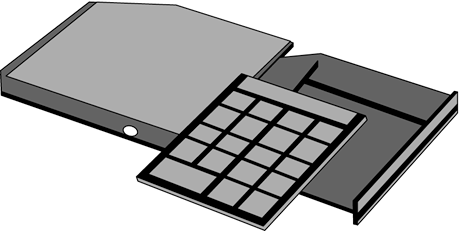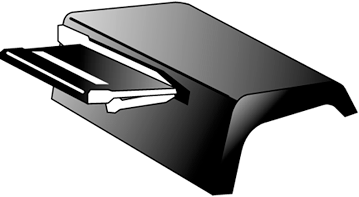Internal Device Bays
| Portable systems have one additional advantage over desktops. It is usually quite easy to add a new storage drive. All one has to do is pop out an existing drive and snap in a new one. This is made possible by the use of modular device bays. The original purpose of these device bays was to allow notebook designers to build a lightweight notebook with only two spindles or drives. The problem was that most people needed three drives: a hard drive, a floppy, and a CD-ROM drive. An internal device bay enabled users to swap the floppy for the CD-ROM drive, or vice versa, whenever needed. In those rare cases where users needed all three drives simultaneously , some manufacturers supplied a cable that enabled the floppy drive to be used in an external configuration. At the current time, floppy drives are becoming less and less useful. In fact, many notebook manufacturers no longer include a floppy drive in their standard configurations. Nevertheless, the swappable internal device bay is still finding use. These bays now make it easy to upgrade notebooks to the latest optical drives. All-in-One SystemsNote that there are two classes of notebooks that have no swappable device bays. The first of these consists of ultralight notebooks or subnotebooks. These systems lack bays for the simple reason that they are too small to have any drive other than a hard drive. For these systems, floppy drives and CD-ROM drives are connected via an external cable. The new Tablet PCs usually fall into this category as well. The second group of all-in-one systems consists of large, old three-spindle notebooks that are equipped with a hard drive, a floppy, and a CD-ROM drive. When these laptops were built, that was all you needed on a notebook ”and pretty much all you could have on a notebook. Now, of course, a much greater variety of drives is available. Proprietary BaysUnfortunately, all the major notebook manufacturers use proprietary bay designs. A given storage bay device works only with notebooks from a single manufacturer, and then often only with a portion of a manufacturer's entire notebook line. Notebook designers use proprietary bay designs for two reasons. The first is the same reason they use proprietary docking-station connectors ”to keep their customers from switching to another notebook manufacturer. The theory is that if a customer has a large investment in modular bay devices, there is less chance he will switch to a new notebook manufacturer and thus make his investment worthless. Another reason for proprietary bay designs is to allow overall design flexibility. In the laptop world, device bay modules are relatively large and, as a result, are limiting factors in the overall design of the systems. As laptops decreased in size, the device bays had to decrease in size as well. In order to achieve leading-edge lightweight designs, manufacturers could not afford to wait for a standards organization to ratify a new device-bay standard. Yet another factor is the lack of a single dominating laptop manufacturer. The desktop market benefited from the early supremacy of the IBM PC and AT. For better or worse , many of the features and components of these IBM systems became de facto standards for the industry. By the time laptops evolved into the mainstream, however, IBM was no longer the dominant player in the industry, and certainly not in the portable market, where it had limited success until the debut of the ThinkPad in the early 1990s. Toshiba was for many years the most successful laptop manufacturer, but at no time was its dominance so great that any other manufacturer would deign to offer laptops that were marketed as "Toshiba compatible." Device bay designs change fairly frequently. The main reason for this is size. As notebooks get smaller and the optical drives get thinner, modular bays can likewise get thinner. The three largest notebook manufacturers have among them almost 15 bay designs. A list of bay designs for three of the most popular notebook manufacturers is given in Table 14.2. Table 14.2. Internal Device Bays: Descriptions of the Bay Designs Used by the Three Largest Notebook Manufacturers
The following sections detail some of the more common proprietary device bay types. Dell Device BaysUnlike most of the other top- tier notebook manufacturers, Dell does not provide special names for the device bays in its notebooks. The company simply refers to them as module bays or media bays . Probably the only time the company announced a trademarked name for a device bay was back in 1999 when it designed a second device bay for its Inspiron 7500 laptop. The company christened this bay the MegaBay, but did not use it on many other notebooks. In line with Dell's low emphasis on the specific module bay design in a particular notebook, the company instead bases its compatibility on two distinct families of notebooks: The Inspiron line is designed for home and small office uses, whereas the Latitude line is designed for medium and large businesses. In general, components such as module bay devices and docking stations are interchangeable within these two families, but not necessarily between them. Some exceptions do exist, however. A few hard-drive modules are interchangeable between the old Latitude C series and some of the Inspiron models. When you order an optional module bay device for your notebook, Dell wants to know which model notebook you have rather than what module bay design is present. Dell has been able to maintain compatibility within the two families for several years. Dell is one of the few companies that also offers drive bay modules for some of its desktops as well as its notebooks. Some of the small-footprint desktops in the OptiFlex family are capable of using the same modules available for the Latitude notebooks. IBM Device BaysIn stark contrast to Dell's approach, IBM has no less than six device bay designs, each with its own trademarked name and all of them variations on the name UltraBay . The latest incarnation, the UltraBay Slim, appeared on the ThinkPad T30 thin & light notebook. For larger notebooks, the current device bay design is the UltraBay Plus. This bay design is similar to the earlier UltraBay 2000 design, except that it supports more devices. For the most part, bay devices are not interchangeable. The only exception is the UltraBay Plus, which also accepts UltraBay 2000 devices. IBM has produced a number of interesting devices to populate these modular bays. One is a pop-out numeric keypad. In its extended position, this keypad sits conveniently to the right side of the main keyboard (see Figure 14.8). Another interesting option is the PDA storage device. This is a small drawer that can store a Palm-style PDA. Figure 14.8. The IBM numeric keypad. This keypad fits into a ThinkPad UltraBay slot and pops out when needed, just to the right of the main keyboard. On some ThinkPads, IBM has one other device bay of sorts. The UltraPort is a very small bay located at the top of the LCD screen, and only a few devices are designed to fit it (see Figure 14.9). These include a video camera and a memory-card reader. Figure 14.9. The IBM UltraPort Compact Flash reader. This device attaches to the top of certain ThinkPads. Toshiba Device BaysToshiba has four notebook families and four module bay designs roughly spread out among them. The aptly named Modular Bay was used in the early Satellite notebooks. More recent Satellites use the Style Bay design. The Tecra 8000 series of notebooks used the SelectBay design, whereas later Tecra models joined the Satellite Pro and Portege notebook families and used the Slim SelectBay device bay. Types of Modular Bay DevicesWhen modular device bays first appeared only two options were available: a CD-ROM drive and a floppy drive. Now, there are a fairly large number of such devices. The exact number of devices varies depending on which notebook you have. Here is a list of typical devices available from the top-tier notebook manufacturers:
Not all manufacturers make all these devices available for all the different bay types. Because the modular bays are a proprietary design unique to each laptop manufacturer and product line, bay devices are usually not readily available in the aftermarket. Also, you will find that once a particular bay is no longer being included in new models, the available accessories disappear very quickly. It is very hard, for example, to find bay devices for sale that fit obsolete models. It is therefore a good idea to purchase the bay accessories you want when the system is new, because they may not be available a year or so later when the manufacturer is including different bays in it newer systems. The Device Bay SpecificationIt is interesting to note that back in March of 1997, Compaq, Intel, and Microsoft, along with a significant number of other leading PC, chipset, software, and peripheral companies announced the creation of the Device Bay specification. Device Bay was to be a specification for interchangeable, modular plug-in peripheral devices, such as hard disk drives, modems, network adapters, CD/DVD drives, and a variety of other devices. This would have brought fully interchangeable, swappable bay peripherals not only to laptops but desktop systems as well! Device Bay was to internally use both USB and IEEE 1394 (FireWire/i.LINK) as the methods of electrically connecting the device to the system. Unfortunately, due mainly to political problems between various companies having stakes in FireWire and USB together, the standard never fully got off the ground. By the time the official specification was released, most of the member companies had abandoned any potential products that might use it; only a handful of products ever made it to market and were quickly withdrawn. The Device Bay working group eventually disbanded, and the specification was transferred to the 1394 Trade Association, where it seems to have died after the last version was published in early 2000. It is too bad that this standard was never realized; it would have made bay devices compatible among different product lines, manufacturers, and even between laptop and desktop systems. | ||||||||||||||||||||||||||||||||||||||||||||||||||||||
EAN: 2147483647
Pages: 182

